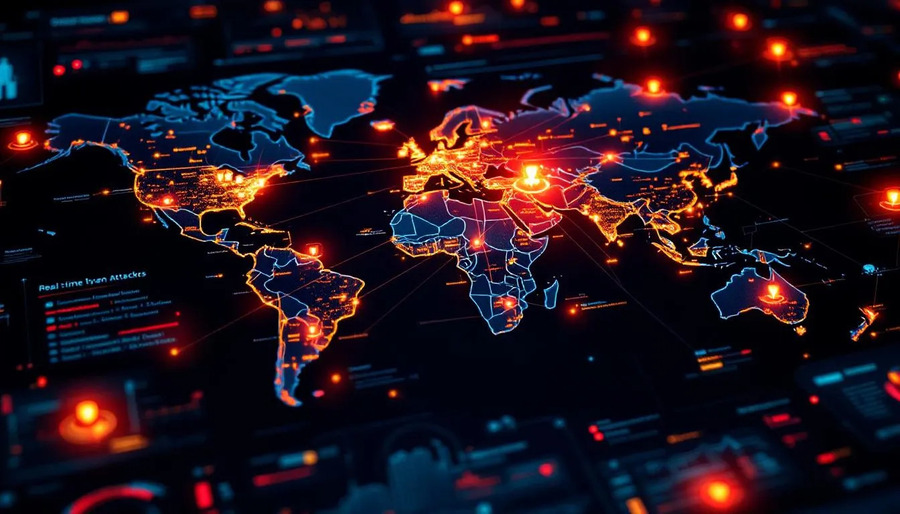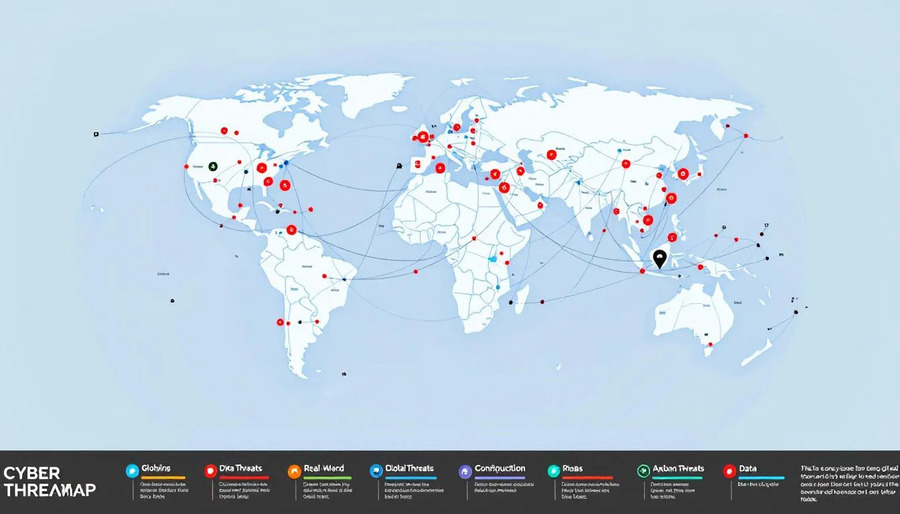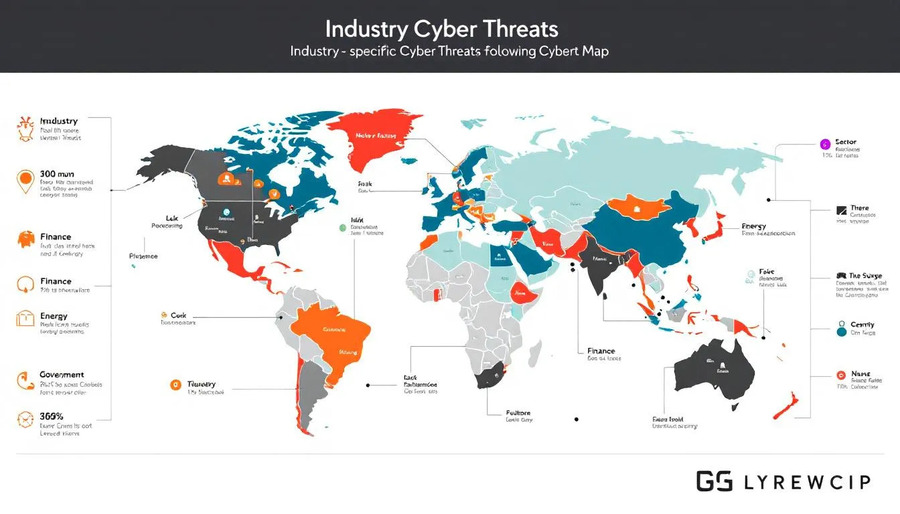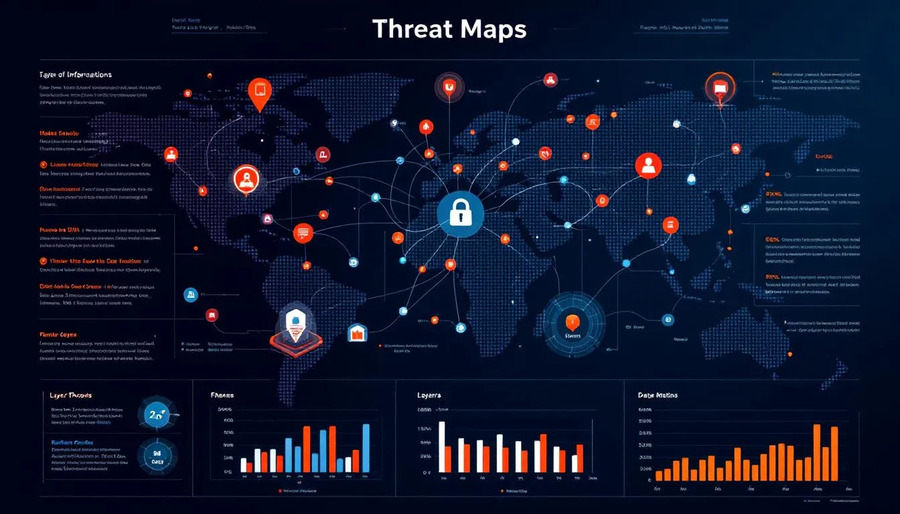I always want to see where cyber attacks are happening in real-time. This article explores the best live maps of Internet Attacks. Each one of these tools provides a map of internet attacks, offering an up-to-the-minute view of global cyber threats, helping you stay informed and proactive.
This post is a follow-up to my other article about trends in cybersecurity.
Key Takeaways
- Real-time threat maps are essential tools for cybersecurity teams, providing immediate insights into ongoing cyberattacks and facilitating targeted responses.
- Different sectors face unique cyber threats, with healthcare and financial institutions particularly vulnerable to attacks like phishing and ransomware; understanding these threats is critical for defense strategies.
- The future of threat maps lies in cutting-edge technologies, such as AI and related machine learning, which will enhance threat detection accuracy and enable real-time data processing and improved visualization techniques.
Top Real-Time Threat Maps

Real-time threat maps are the frontline tools that security teams rely on to quickly identify the frequency and intensity of cyber attacks. These maps provide immediate insights into internet threats without the need to sift through vast amounts of data, making them indispensable in today’s fast-paced cybersecurity landscape.
What sets these maps apart is their ability to offer unique visualization tools:
- Users can zoom in and rotate views to focus on specific countries.
- They reveal localized threat data that is crucial for targeted responses.
- They combine quick insights with interactive features on the globe.
Real-time threat maps enhance organizational cybersecurity measures effectively.
These maps serve as critical tools for cybersecurity experts, providing a snapshot of ongoing cyber threats globally. They not only help in understanding the broader threat landscape but also play a crucial role in identifying and mitigating possible risks before they escalate.
Understanding Cyber Attacks
Cyber attacks are malicious activities aimed at damaging or disrupting networks and systems. These attacks can take various forms, including:
- Phishing: involves deceptive emails that trick individuals into revealing sensitive information, making it a prevalent and dangerous form of attack.
- Ransomware: a kind of malware that encrypts the victim’s personal information until a ransom is paid.
- Distributed denial of service (DDoS) attacks: a vicious attempt to disrupt the usual traffic of a targeted infrastructure or service by flooding the target or its surroundings with Internet traffic.
Each type has its unique impact and method of execution.
Different sectors face unique threats:
- Healthcare organizations are key targets due to the sensitive nature of patient data, which cybercriminals can exploit for financial gains.
- Phishing attacks in healthcare settings often target staff to gain unauthorized access to patient information, highlighting the sector’s vulnerability.
- The financial sector faces targeted threats like ransomware, which can cause considerable economic and reputational damage.
Understanding these cyber threats is important for developing effective defense strategies. The MITRE ATT&CK framework, for instance, aids in understanding the tactics and methods used by attackers, facilitating better threat preparedness. By grasping the nature of these attacks, organizations can better protect themselves and respond more effectively to threats.
Key Features of an Effective Threat Map
Effective threat maps are essential for visualizing ongoing cyber attacks globally, providing a broad overview of the current threat landscape. These maps allow organizations to understand the global context of cyber threats, making it easier to identify and respond to potential risks. Displaying real-time attack patterns, threat maps provide valuable insights into cybercriminal tactics.
One of the key features of an effective threat map is its ability to integrate with existing security infrastructure. This integration improves the overall effectiveness of security measures by providing a comprehensive view of threats. Collaboration with external threat intelligence sources further expands the range of data available for threat detection and response, making it easier to stay ahead of emerging threats.
Future advancements in threat maps will likely focus on incorporating machine learning and automation to improve the accuracy of threat detection and response. These technologies can reduce response times considerably and improve analysis accuracy, making threat maps even more indispensable tools in the fight against cybercrime.
Popular Global Threat Maps

Global threat maps serve as real-time visualization tools, offering insights into active cyber threats worldwide. Major global threat maps like those from FireEye and Kaspersky incorporate unique visualization techniques that help users understand the dynamics of cyber threats. Utilizing these maps leads to improved organizational readiness and quicker response times to emerging threats.
In the following sections, we will explore three of the most popular global threat maps: FireEye, Kaspersky, and Fortinet. Each of these maps has its unique features and benefits, providing invaluable tools for organizations looking to bolster their cybersecurity defenses.
1. FireEye Threat Map
FireEye’s threat map provides interactive visualizations that help organizations identify and analyze ongoing cyber threats globally. This map offers real-time visualizations of cyber threats, allowing organizations to assess potential risks dynamically. It utilizes a refined set of real attack data to enhance visualization, making it easier for users to grasp the current threat landscape quickly.
Offering a comprehensive view of current attack locations and types, FireEye’s threat map helps organizations monitor the threat landscape effectively. This tool is particularly useful for security teams looking to understand and mitigate the risks posed by cyber threats.
2. Kaspersky Cyberthreat Real-Time Map
Kaspersky’s cyberthreat real-time map offers interactive features, allowing users to rotate and zoom into specific countries for detailed threat information. This map provides an overview of cyber threats globally, helping users understand the current landscape of cyber attacks. Visualizing data on various types of cyber threats and attacks enables users to identify trends and respond proactively.
The enhanced data visualization tools in Kaspersky’s map help in recognizing patterns and anomalies in cyber-attack metrics, making it an invaluable resource for organizations looking to stay ahead of potential threats.
3. Fortinet Threat Map
The Fortinet Threat Map provides a real-time representation of cyber threats around the world, helping organizations gauge the landscape of cyber vulnerabilities. Using advanced data analytics, the Fortinet Threat Map visualizes attack trends across various regions, making it easier for security teams to prioritize their response efforts. It includes features such as interactive graphics, threat intelligence feeds, and the ability to filter data based on attack type and geography.
Showcasing live attack data, Fortinet’s map helps organizations:
- Understand and anticipate emerging threats in real-time, enhancing their cybersecurity posture
- Identify the origins and targets of various cyber attacks
- Gain essential insights into the global distribution of threats
Regional Threat Maps
Regional threat maps are essential tools in understanding and monitoring cyber threats that may target specific geographical areas. These maps offer real-time data feeds, visualization tools, and analysis features that are tailored to local threats, making them invaluable resources for organizations operating within specific regions. Understanding and utilizing regional threat maps can greatly improve an organization’s readiness against cyber threats targeting their specific regions.
In the following subsections, we will explore three notable regional threat maps: the US-CERT National Cyber Awareness System, Brazil’s CERT.br, and Switzerland’s MELANI. Each of these maps provides unique insights and tools to help organizations defend against localized cyber threats.
1. US-CERT National Cyber Awareness System
The US-CERT National Cyber Awareness System issues alerts and advisories to inform the public about current threats and vulnerabilities. It plays a critical function in protecting national cyber infrastructure by providing timely information that helps organizations and individuals take necessary actions to safeguard their systems against cyber threats.
These alerts are important for maintaining a proactive cybersecurity posture.
2. Brazil’s CERT.br
CERT.br specializes in monitoring and analyzing threats that are specifically targeting Brazil organizations. The threats monitored by CERT.br include a variety of cyber attacks that pose risks to the infrastructure and safety of Brazilian enterprises.
CERT.br helps enhance the nation’s overall cybersecurity resilience by providing analysis and response strategies.
3. Switzerland’s MELANI
MELANI, the Swiss Reporting and Analysis Centre for Information Assurance, focuses on enhancing cybersecurity in Switzerland by providing a comprehensive threat map. This map visualizes real-time cyber threats, helping users understand current vulnerabilities in the Swiss cyber landscape.
MELANI employs a collaborative approach with various stakeholders, including government agencies and private sector organizations, to share vital threat intelligence, significantly enhancing the resilience of Switzerland’s cyber defenses.
Industry-Specific Threat Maps

Industry-specific threat maps play a crucial role in identifying unique cyber risks faced by various sectors. These maps highlight unique cybersecurity challenges and attack patterns relevant to different industries, helping organizations prioritize defenses. Understanding specific vulnerabilities and attack vectors each sector faces enables these maps to provide more targeted and effective cybersecurity strategies.
In the following subsections, we will explore industry-specific threat maps for financial institutions, the healthcare sector, and government agencies. Each of these maps addresses the unique challenges and threats faced by these industries.
1. Financial Institutions
Ransomware remains the dominant threat in the financial sector, with many institutions experiencing significant financial and reputational damage due to such attacks. Cybercriminals increasingly utilize Ransomware-as-a-Service (RaaS), enabling even less technically skilled individuals to conduct sophisticated attacks on financial institutions.
These tailored threat maps help financial institutions better understand and mitigate these risks.
2. Healthcare Sector
In healthcare, threat maps focus on protecting patient data and ensuring operational continuity against cyber incidents that could jeopardize patient care. These maps are crucial for identifying and mitigating threats that specifically target the sensitive nature of healthcare data, helping to maintain the integrity and confidentiality of patient information.
3. Government Agencies
Government agencies face unique cybersecurity challenges due to the sensitivity of the data they handle, necessitating specialized threat mapping. The data managed by government entities is highly sensitive, requiring heightened security measures to ensure its protection.
Compliance with regulatory frameworks and rigorous testing are crucial for improving the cybersecurity posture of government agencies.
Tools and Techniques for Analyzing Threat Maps
Analyzing threat maps is crucial for understanding the current cybersecurity landscape and identifying potential risks. Effective threat maps combine their insights with other sources of threat intelligence for a comprehensive view of the cybersecurity landscape. Utilizing advanced tools and techniques, organizations can gain deeper insights into threat patterns and enhance their ability to respond to emerging threats.
Tools like Jigsaw, for example, help in visualizing and analyzing complex data sets, making it easier to identify trends and anomalies in cyber threats. Integrating these tools with threat maps enhances organizations’ analytical capabilities and improves their overall cybersecurity posture.
Building a Response Team
A successful response team is essential for effectively managing and responding to cyber threats. This team should be comprised of individuals with diverse expertise, including IT security, incident response, and effective communication skills. Setting explicit roles and responsibilities within the team can enhance efficiency during a cyber threat response.
Real-time communication tools can significantly improve coordination among team members during a crisis. Regular monitoring of threat maps enables organizations to stay informed about new threats, ensuring timely contact and effective incident response.
How Organizations Use Threat Maps

Threat maps can enhance collaboration among cybersecurity teams by raising awareness about emerging threats. They also offer educational benefits, facilitating discussions on current and emerging cyber threats among security teams. The US-CERT National Cyber Awareness System, for example, provides timely alerts and guidance on cybersecurity threats, enhancing national resilience against cyber incidents.
Government agencies utilize threat maps to monitor and mitigate risks associated with national security, critical infrastructure, and sensitive citizen information. Predicting and preventing cyber threats, these maps play a crucial role in guarding national security and ensuring the safety of sensitive information from foreign adversaries.
Future Trends in Threat Map Technology

The next generation of threat maps is expected to feature:
- Real-time data processing capabilities provide instant updates on cyber threats.
- Advancements in visualization techniques that allow threat maps to present complex data in more intuitive formats, enhancing user comprehension.
- Increased employment of AI and machine learning to analyze threat patterns and predict potential cyber threats, enhancing the proactive capabilities of threat maps.
Machine learning algorithms will enable threat maps to learn from previous attacks and improve threat detection accuracy over time. Future threat maps will offer increased customization options, allowing organizations to tailor maps to their specific security needs and priorities, significantly enhancing their overall cybersecurity posture.
Concluding Remarks
At a time when cyber threats are becoming progressively sophisticated, the need for advanced threat detection and response tools is paramount. Real-time threat maps offer a powerful solution, providing immediate insights into the global and regional cyber threat landscapes. From global giants like FireEye, Kaspersky, and Fortinet to regional stalwarts like US-CERT, CERT.br, and MELANI, these maps are indispensable tools that help organizations stay ahead of cyber threats.
By comprehending the nature of cyber attacks and leveraging the unique features of these threat maps, organizations can enhance their cybersecurity measures, improve their response times, and better protect their critical assets. As technology progresses, so too will the abilities of threat maps, incorporating AI, machine learning, and advanced data visualization techniques to provide even more accurate and actionable insights. The future of cybersecurity is bright, and with the right tools and strategies in place, organizations can navigate the difficult digital landscape with confidence.
Remember to read my other articles about cybersecurity, including the interesting one that explores Bitdefender Central and other exciting Bitdefender products.
Frequently Asked Questions
1. What are real-time threat maps?
Real-time threat maps are essential visualization tools that deliver immediate insights into active cyber threats, enabling organizations to swiftly recognize and respond to potential attacks. These maps enhance situational awareness and promote timely defensive measures.
2. How do threat maps benefit organizations?
Threat maps are essential for organizations as they offer insights into global and regional threat landscapes, allowing for enhanced cybersecurity measures and quicker response times to emerging threats. By utilizing threat maps, organizations can proactively bolster their defenses against potential risks.
3. What are some popular global threat maps?
Some popular global threat maps are FireEye’s Threat Map, Kaspersky’s Cyberthreat Real-Time Map, and Fortinet’s Threat Map, each providing valuable insights into cybersecurity threats. These tools are essential for understanding the current landscape of global cyber threats.
4. Why are industry-specific threat maps important?
Industry-specific threat maps are crucial as they identify unique cybersecurity challenges and attack patterns pertinent to various sectors, enabling organizations to prioritize defenses and effectively mitigate specific risks.
5. What future advancements can we expect in threat map technology?
You can expect future advancements in threat map technology to feature real-time data processing, integration of AI and machine learning for enhanced threat detection, and improved data visualization techniques to facilitate better understanding.



